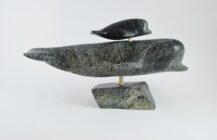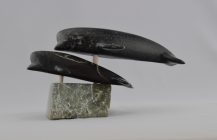Isa Oqutaq

(1957 – ) | Tikiraq, Nunavut, Canada
Isa Oqutaq was born on April 25, 1957 to Enookie Oqutaq and Qimirpikaluk Oqutaq at a place near Cape Dorset called Tikiraq, meaning small point. Isa has 3 sisters, Napatchie Oqutaq, Pauojoungie Saggiak and Letia Etidloie, adopted to Kov Parr. Isa’s younger brother Latsaulaasie was adopted into their family from Ashoona and Sammia Namonai. Pauojoungie Saggiak is recently producing drawings and has prints in recent Cape Dorset Print collections.
In his own words – “I remember Tikiraq as a special place when the weather warms up during the spring animals are plentiful. There are an abundance of seals and other marine life such as whales and walrus. It is a good place for hunting. There are many species of ducks making a lot of noise with their mating calls during May and June. There are seagull cliffs close by where seagulls nest and make noise too. I remember the mornings when coming out of the tent, there is no wind, there is sunshine and the smell of the fresh earth and plants being unveiled under the recent melting snow. When the weather is nice, the seas are calm, Tikiraq is a beautiful place to be with the possibility of so many animals passing by including the polar bears.
When I was younger we used to move from place to place. We lived at Tikiraq on and off over the years. When I was 3 years old my family moved to Iqaluit where a lot of other families from South Baffin were moving to because there was work at the US airbase. At that time Iqaluit was small. I grew up in Iqaluit, where we lived on the beach in a qammaq that my father had built. A qammaq is a framed tent with canvas on the inside and outside walls with arctic heather for insulation between the two layers of canvas. Other family lived close by. Qimirpikuluk’s brother Adamie Alariaq, lived there with his family.
I was about 5 or 6 when I started going to school. My father was working building houses then, and we would continue to go out on the land for a couple of weeks during the spring and summer. In school I could not understand reading, spelling or arithmetic. School was difficult for me.
My father, Enookie is well known for his scrimshaw carvings on ivory and caribou antlers. I learnt from my Dad when he was using tools like saws and chisels to make his carvings. It used to take a long time to make a carving, like a week for my Dad to make a large piece. At that time I only watched him carving. He used to make walrus and whales. He carved scrimshaw on caribou antler and ivory, and made ivory into jewelry such as pendants and rings. I started to carve around 1974 when I was 17, carving beluga whales when I did not have another job. I carve mainly using soapstone and sometimes marble. I will use caribou antler for a base on my carving when I make a pod of whales.
I used to help my uncle Quvianatuliak Tapaungai mine the stone when he went out soapstone mining. He had the equipment and the boat to travel to the mine site. My uncle has stopped going out to the mine site as he is an elder and since then I have not gone out on the land.
My father and Iqaqtilik’s father were brothers. Iqaqtilik is the mother of Tony. I call him my nephew. Tony Oqutaq is my niece’s son.
I do all the work on my own carvings including the sanding and polishing. The stone is similar through the years, but there are all kinds of different stone depending on where people go to mine the stone. There is green, black, and light and dark soapstone. There is white marble and black marble.
I used to make whales in my early carving years until I was asked by Sandy Reynolds to make an inuksuk. He bought me a 3-foot high piece of stone to make an inuksuk. I looked at an inuksuk by Cape Dorset and saw how the rocks were piled and I tried to make it look like this one. It was the first inuksuk that I made. Since then I have been making inuksuit for many people and buyers that come to Cape Dorset. I think about the inuksuit that I have seen on the land when I am carving. There are many different shapes. I now work full time doing the carvings. This is the only way I make a living now. ”



